Short limbed supple skink
3- Supple Skink (Krabi, Thailand)
Family : SCINCIDAE
Species : Lygosoma sp.
Size (snout to vent) : this specimen approx 3 cm
Size (total length) : this specimen approx 6 cm (with broken tail).
Habitat :
L. haroldyoungi is found in tropical deciduous forest and cultivated areas.[3]
Conservation status :
L. haroldyoungi is threatened by habitat loss but this is not a significant threat as it survives in agricultural areas.[3]

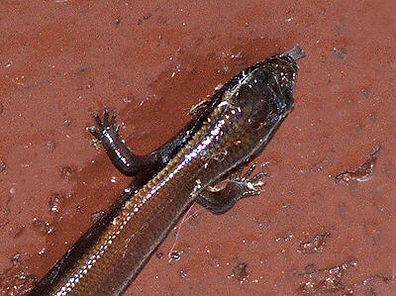
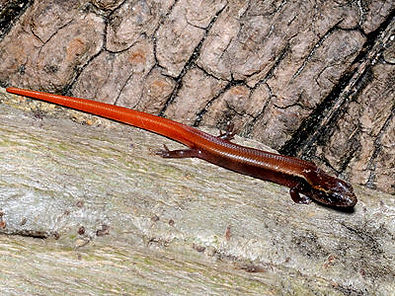
Bowring's supple skink burrowing
The skink illustrated here was found near human habitation adjacent to karst limestone habitat, in Krabi, southern Thailand. It was active in the midday sun.
It measures just 3 cm from snout to vent, and around 6 cm total length (with partly broken tail).
This appears to be a juvenile Lygosoma skink, with an unusually bright red tail. Possible species include the White Spotted Supple Skink L. albopunctatum or Spotted Supple Skink L. punctatum, however neither of these species are listed as being extant in Thailand, though they do occur in parts of neighbouring Burma(Das, 2010).
The body of this juvenile skink is slender, and dark brown throughout, with flanks slightly darker than the dorsum. A few faint, pale speckles are apparent on the anterior part of the flank near the origin of the forelimb.
Its forelimbs and hindlimbs are short, as are its fingers and toes. Its body scales appear smooth to weakly keeled.
Figs 1 and 2 above : Two images of a juvenile Lygosoma skink from Krabi, southern Thailand.
Photos & videos :
From Wikipedia, the free encyclopedia
The banded supple skink or Harold's writhing skink or Harold Young's supple skink[2] (Lygosoma haroldyoungi ) is a species of skink in the family Scincidae.[3] The species is endemic to Southeast Asia.
Banded supple skink
Conservation status
Scientific classification
Kingdom:Animalia
Phylum:Chordata
Subphylum:Vertebrata
Class:Reptilia
Order:Squamata
Suborder:Sauria
Infraorder:Scincomorpha
Family:Scincidae
Subfamily:Lygosominae
Genus:Lygosoma
Species:L. haroldyoungi
Binomial name
Lygosoma haroldyoungi
(Taylor, 1962)
Geographic range of Lygosoma haroldyoungi in Southeast Asia.
Synonyms :
-
Riopa haroldyoungiTaylor, 1962
-
Lygosoma haroldyoungi— Nabhitabhata, 2004
-
Riopa haroldyoungi— Moravec & Böhme, 2008
-
Lygosoma haroldyoungi— Geissler et al., 2012[1]


Etymology:
The specific name, haroldyoungi, is in honor of American missionary Harold Young, who worked in Burma (now Myanmar) and Thailand.[2]
Geographic range :
L. haroldyoungi is distributed in northern, central, and eastern Thailand and neighbouring Laos (Moravec and Böhme 2008). In Thailand it has been found in the provinces of Chachoengsao, Chaiyaphum, Chanthaburi, Chiang Mai, Chiang Rai, Nong Khai, Phetchabun, Phitsanulok, Nakhon Ratchasima, and Loei.[3] In Laos it occurs in Vientiane Province, and it is also found in Myanmar.[1]
For the external links , refrences click here to read the full wikipedia article
LIPINIA skinks: or Striped Skinks, are slender, small skinks with smooth, shiny scales, narrow bodies and thin legs. They are terrestrial or arboreal and are secretive in habits. Some species are striped, and others plain coloured. Around 30 species are recognised, the majority of which occur in Southeast Asia and New Guinea. Examples :
- Moth Skink :
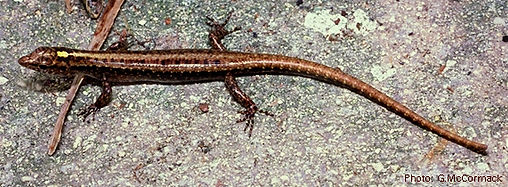
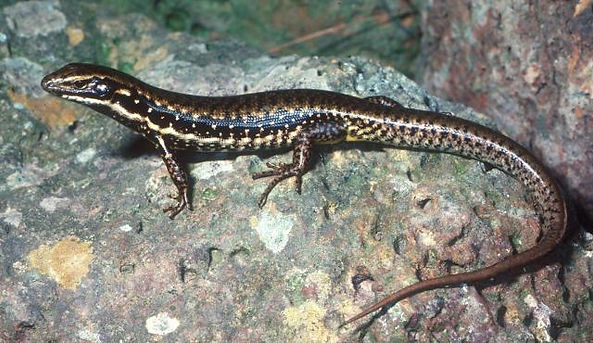

Moth Skink
courtesy to : www.ecologyasia.com/verts/lizards/moth-skink.htm
Family : SCINCIDAE
Species : Lipinia noctua
Size (snout to vent) : up to 4.7 cm
Size (total length) : up to 12 cm
The Moth Skink occurs in forests and disturbed habitats on islands in eastern Indonesia and the Pacific Ocean.
In disturbed areas it may be terrestrial in habits, but in good forest it is arboreal, and is often associated with the crowns of palms (Zug, 2013).
This small skink is easily identified by the pale, yellowish marking on the occiput, which is bordered with dark brown, and connects to a pale stripe running down the middle of the back. (The 'occiput' is the anatomical term for the back part of the skull). There is a broad, dark brown stripe on the flanks which is speckled with pale brown spots. The rest of the body is medium brown, and the tail is orange-brown.
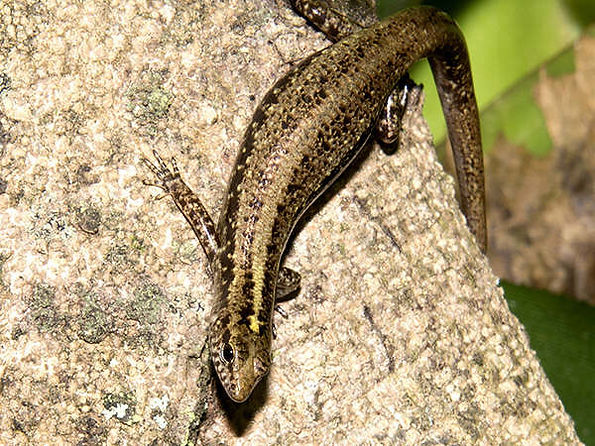

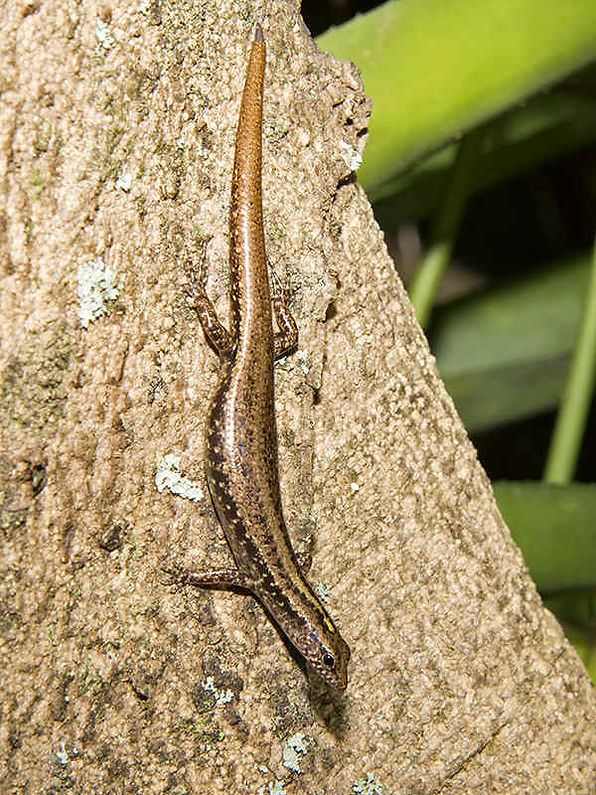
Its body is broad and its tail is thick and rounded in cross-section. Its limbs are short and slender, and its finger and toes are very short. Its scales are smooth and glossy.
It is unclear why this lizard is called a 'Moth Skink'.
In eastern Indonesia its range includes Sulawesi and Maluku. In western and central Pacific it is found on New Guinea, Solomon Islands, Vanuatu, Fiji, Samoa, Cook Islands, Hawaii and many other smaller island groups.
Figs 1 to 3 above : Specimen from Rarotonga, Cook Islands. It was active late in the afternoon on the buttress of a large tree, close to a beach. It was rather shy, and would quickly retreat to safety when disturbed.
4- Bowring's Supple Skink:
courtesy to : www.ecologyasia.com/verts/lizards/bowrings_supple_skink.
Family : SCINCIDAE
Species : Lygosoma bowringii
Size (snout to vent) : 6 cm
Size (total length) : 12 cm
Bowring's Supple Skink can be found in various habitats including forests, agricultural areas, gardens and parklands. Unless sunning itself, this terrestrial skink largely remains hidden under leaf litter. Though common, it is quick to move away from disturbance and is often overlooked.
The species is characterised by its small size, slender body, and tiny limbs. The dorsal surface is brownish grey, the sides speckled, and the ventral surface mottled yellow.
According to Das (2010), juveniles possess a bright red tail.
It ranges widely from India, Burma, Thailand, Indochina and southern China to Peninsular Malaysia, Singapore, Borneo, Sumatra, Java, Sulawesi and the Philippines.
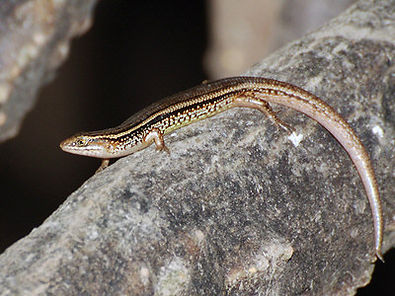

Figs 1 and 2 : Adult (probably male) at Pulau Semakau, Singapore. This specimen was disturbed on a rock bund : it promptly swam across a few metres of calm, mangrove water and climbed an aerial root of a Rhizophora sp.
Video :
Skink Lipinia spp vittigera
Other websites :
- reptile-database.reptarium.cz/species?genus=Lipinia&species=noctua
- en.wikipedia.org/wiki/Lipinia_noctua
- explorer.natureserve.org/servlet/NatureServe?searchName=Lipinia+noctua
- cookislands.bishopmuseum.org/species.asp?id=8569
- Yellow Striped Tree Skink
courtesy to : www.ecologyasia.com/verts/lizards/yellow_striped_tree_skink.htm
Family : SCINCIDAE
Species : Lipinia vittigera
Size (snout to vent) : 4.2 cm
Size (total length) : 10 cm
This attractive little skink inhabits tree trunks in lowland primary and secondary forest up to 1600 metres elevation. It is rarely seen on account of its extreme shyness : it will quickly hide itself in a tree crevice under the slightest disturbance.
The Yellow Striped Tree Skink is easily identified by its slender shape, bright orange tail and black and yellow striped body. Its diet probably comprises small insects.
The species ranges from Burma, Thailand and Vietnam to Peninsular Malaysia, Singapore and Borneo.


Fig 1 : Specimen in primary, lowland forest on Penang Hill, Pulau Pinang, Peninsular Malaysia
Fig 2 : Specimen from Bukit Timah Nature Reserve, Singapore.
Photos & Videos :
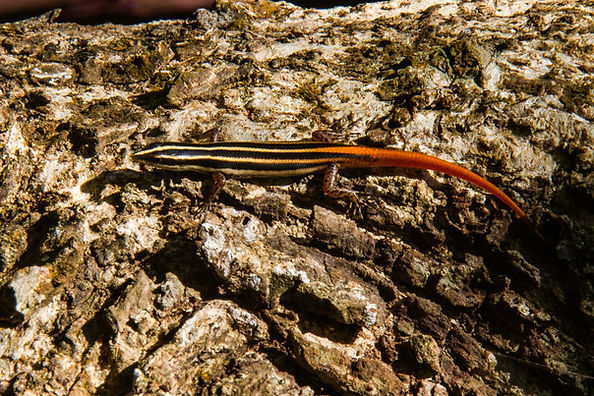
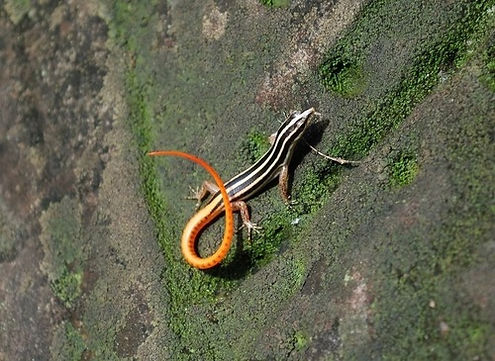

Lipinia vittigera, striped tree skink lizard, Khao Yai National Park
จิ้งเหลนต้นไม้หางส้ม(Striped Tree Skink)
All images from Phnom Kulen National Park in central Cambodia.
Reference : Ouboter, P.E. 1986. A revision of the genus Scincella (Reptilia: Sauria: Scincidae) of Asia, with some notes on its evolution. Zool. Verh. Leiden 229: 1-66.
SCINCELLA skinks : or Ground Skinks, are small, skinks, with relatively long tails, fairly thick bodies, and short slender limbs. They are terrestrial in habits and appear less shy than other ground-dwelling skinks. More than 30 species have been described, of which less than half occur in Southeast Asia. Examples :
- Ground Skink (Cambodia) :
Family : SCINCIDAE
Species : Scincella sp. (S. melanosticta or S. reevesii)
Size (snout to vent) : 5.7 cm
Size (total length) : 17 cm ?
These images are of five separate individuals of a species of Ground Skink (Scincella sp.) from Phnom Kulen National Park in central Cambodia.
Based on Ouboter (1986) these skinks are likely to be either the Black-spotted Ground Skink
S. melanosticta, or Reeves's Ground Skink
S. reevesii. Both species are similar in terms of pattern and colour : inspection of scale characteristics would be required to determine the exact species.
All five skinks were found at low elevations
(200 metres or less) near Kbal Spean in the west of the national park, in an area of partly disturbed, wet semi-evergreen forest. They were either active on damp, mossy boulders or tree roots, or on dry sandy soil near the entrance to small caves or rocky overhangs.
The skinks' bodies are slender, their head small and eyes relatively small. The limbs are slender.
The dorsal surface is typically bronze, adorned with black speckling. Along each flank is a dark stripe, broken up by pale spots and mottling. Variation in intensity of colour and patterning is evident between individuals, with larger skinks seeming to be more orange in colour (particularly the tail) with reduced speckling and mottling.
Fully grown males in breeding colours are reddish-orange.
The known range of the Black-spotted Ground Skink includes Myanmar, Thailand, Cambodia (Cardamom Mountains) and Vietnam. Reeves's Ground Skink occurs in Nepal, Bangladesh, Burma, Thailand, Vietnam, southern China and Korea. Thus, either species could reasonably be expected to occur in central Cambodia.





Fig 1 : A fully grown, male ground skink (Scincella sp.) in reddish-orange breeding colours. Photo thanks to Ian Prothero.
Figs 2 to 5 : Four more specimens of a ground skink from the same location as figure 1.
Other Websites :
- en.wikipedia.org/wiki/Scincella_melanosticta
- bangkokherps.wordpress.com/2011/09/18/long-tailed-sun-skink/
- reptile-database.reptarium.cz/species?genus=Scincella&species=melanosticta
Photos & Videos :
Beautiful Khmer Golden Skink (Eutropis multifasciata)
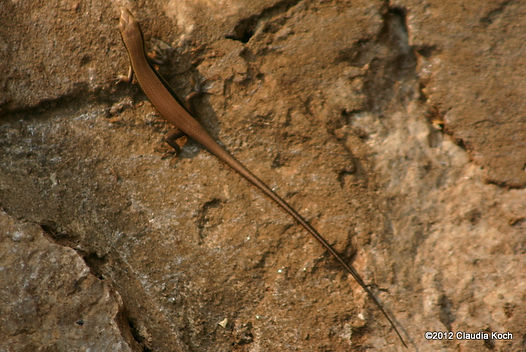


Other Asian Skinks :
Please select or follow below :
SKINKS SPECIES : Blue - tongued skinks : Part 1 - 2 - 3 - 4 - 5 - 6 - 7
Five - Lined Skinks : Part 1 - 2
Other Skinks : ASIAN & AFRICAN skinks : Part 1 2 3 4 5 6 7 8 9 10 11 12 13 14 15
Other Skinks American Part : 1 - 2 - 3
Other Skinks Australian Part : 1 2 3 4 5 6 7 8 9 10 11 12 13 14
Please select or follow below :
SKINKS SPECIES : Blue - tongued skinks : Part 1 - 2 - 3 - 4 - 5 - 6 - 7
Five - Lined Skinks : Part 1 - 2
Other Skinks : ASIAN & AFRICAN skinks : Part 1 2 3 4 5 6 7 8 9 10 11 12 13 14 15
Other Skinks American Part : 1 - 2 - 3
Other Skinks Australian Part : 1 2 3 4 5 6 7 8 9 10 11 12 13 14